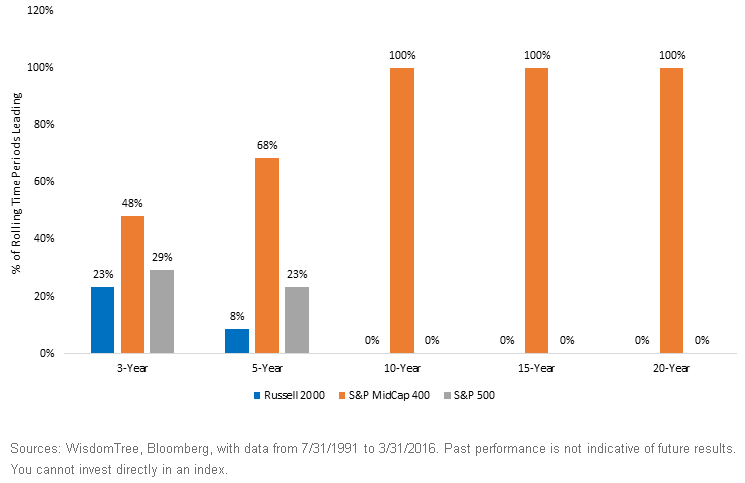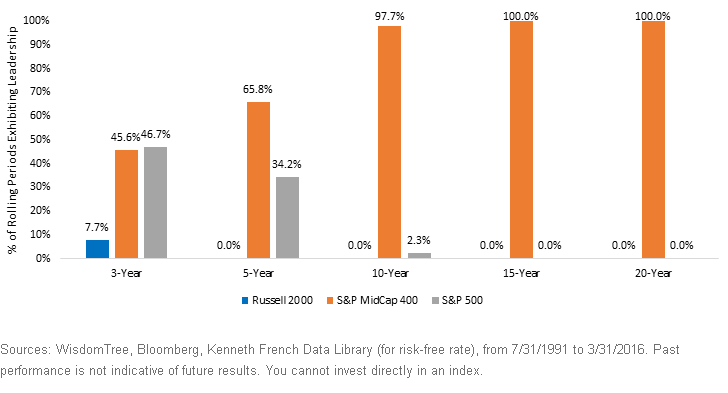Middle Management: Increasing Mid Cap Allocations


 Mid-Cap Risk Isn’t Excessive
Our analysis of rolling periods clearly shows the long-term strength of mid-caps but this doesn’t account for risk. It is the perception of elevated risk that shifts investors’ focus away from mid-caps. Rolling period Sharpe ratios of mid-caps had superior risk-adjusted returns.2
• Rolling Three-Year Periods: We saw that the S&P MidCap 400 beat both the S&P 500 and Russell 2000 indexes in almost 50% of these periods. Shifting from absolute returns to the Sharpe ratio, we see that the S&P 500 and S&P MidCap 400 led during almost the same amount of these periods. The S&P 500 typically had a lower risk, whereas the S&P MidCap 400 typically had higher returns.
• Rolling Five-Year Periods: Interestingly, on an absolute return basis, the S&P MidCap 400 outperformed both the S&P 500 and Russell 2000 indexes about two-thirds of the time. Shifting to the Sharpe ratio yielded the same result, but the biggest change was that the higher risk of the Russell 2000 led to the S&P 500 leading in a greater number of rolling periods.
• Rolling 10-, 15- and 20-Year Periods: Similar to the absolute returns analysis, on a Sharpe ratio basis the S&P MidCap 400 Index dominates both the S&P 500 and Russell 2000 indexes.
Rolling Periods: Mid-Caps Also Did Well at Risk-Adjusted Returns
Mid-Cap Risk Isn’t Excessive
Our analysis of rolling periods clearly shows the long-term strength of mid-caps but this doesn’t account for risk. It is the perception of elevated risk that shifts investors’ focus away from mid-caps. Rolling period Sharpe ratios of mid-caps had superior risk-adjusted returns.2
• Rolling Three-Year Periods: We saw that the S&P MidCap 400 beat both the S&P 500 and Russell 2000 indexes in almost 50% of these periods. Shifting from absolute returns to the Sharpe ratio, we see that the S&P 500 and S&P MidCap 400 led during almost the same amount of these periods. The S&P 500 typically had a lower risk, whereas the S&P MidCap 400 typically had higher returns.
• Rolling Five-Year Periods: Interestingly, on an absolute return basis, the S&P MidCap 400 outperformed both the S&P 500 and Russell 2000 indexes about two-thirds of the time. Shifting to the Sharpe ratio yielded the same result, but the biggest change was that the higher risk of the Russell 2000 led to the S&P 500 leading in a greater number of rolling periods.
• Rolling 10-, 15- and 20-Year Periods: Similar to the absolute returns analysis, on a Sharpe ratio basis the S&P MidCap 400 Index dominates both the S&P 500 and Russell 2000 indexes.
Rolling Periods: Mid-Caps Also Did Well at Risk-Adjusted Returns
 Risk/Return Says Mid-Caps Warrant Consideration
Empirical long-term data proves that mid-caps are strong performers, calling into question the disproportionate amount of attention afforded to large and small caps while mid-caps quietly outperformed on both a risk-adjusted and absolute basis.
1Sources: WisdomTree, Bloomberg, with data from 7/31/1991 to 3/31/2016.
2Sources: WisdomTree, Bloomberg, Kenneth French Data Library (for risk-free rate) from 7/31/1991 to 3/31/2016.
Risk/Return Says Mid-Caps Warrant Consideration
Empirical long-term data proves that mid-caps are strong performers, calling into question the disproportionate amount of attention afforded to large and small caps while mid-caps quietly outperformed on both a risk-adjusted and absolute basis.
1Sources: WisdomTree, Bloomberg, with data from 7/31/1991 to 3/31/2016.
2Sources: WisdomTree, Bloomberg, Kenneth French Data Library (for risk-free rate) from 7/31/1991 to 3/31/2016. 
Christopher Gannatti began at WisdomTree as a Research Analyst in December 2010, working directly with Jeremy Schwartz, CFA®, Director of Research. In January of 2014, he was promoted to Associate Director of Research where he was responsible to lead different groups of analysts and strategists within the broader Research team at WisdomTree. In February of 2018, Christopher was promoted to Head of Research, Europe, where he was based out of WisdomTree’s London office and was responsible for the full WisdomTree research effort within the European market, as well as supporting the UCITs platform globally. In November 2021, Christopher was promoted to Global Head of Research, now responsible for numerous communications on investment strategy globally, particularly in the thematic equity space. Christopher came to WisdomTree from Lord Abbett, where he worked for four and a half years as a Regional Consultant. He received his MBA in Quantitative Finance, Accounting, and Economics from NYU’s Stern School of Business in 2010, and he received his bachelor’s degree from Colgate University in Economics in 2006. Christopher is a holder of the Chartered Financial Analyst Designation.

